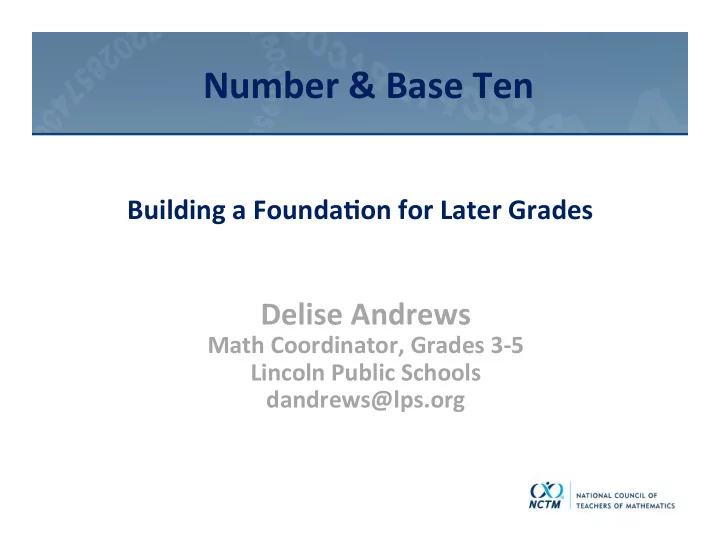

Number & Base Ten Building a Founda,on for Later Grades Delise Andrews Math Coordinator, Grades 3-5 Lincoln Public Schools dandrews@lps.org
Why is place value so tricky? • We o%en fail to take advantage of opportuni3es to support children with the language of place value. • Standard algorithms frequently obscure place value. • We move too quickly to abstract representa3ons. 2
Base Ten 10 2 10 1 10 0 100 10 1 3
Base Five 5 2 5 1 5 0 100 5 10 5 1 5 4
Name this Number (in base five!) 4 ones 4 5 5
Name this Number (in base five!) 2 fives 20 5 6
Name this Number (in base five!) 1 five + 1 one 11 5 7
Name this Number (in base five!) 1 five + 1 one 11 5 8
Name this Number (in base five!) 2 twenty - fives + 2 fives 220 5 9
Basic Facts in Base Five • Work together with your table group to construct an addi3on table in base five. Base 5 Addition Table + 0 1 2 3 4 0 0 1 2 3 4 1 1 2 3 4 10 2 2 3 4 10 11 3 3 4 10 11 12 4 4 10 11 12 13 10
Addi,on in Base Five 23 5 + 34 5 11
Addi,on in Base Five 104 5 + 401 5 12
Subtrac,on in Base Five 44 5 − 32 5 13
Subtrac,on in Base Five 32 5 − 24 5 14
Let’s revisit Base Ten • Solve this problem using 78 manipula3ves. • What knowledge about place value does a student need to use to find the sum? + 89 15
Let’s revisit Base Ten • Solve this problem using 91 manipula3ves. • What knowledge about place value does a student need to use to find the difference? − 19 16
Representa,ons • Concrete (well chosen manipula3ves) • Representa3onal (math drawings) • Abstract (symbolic nota3on) 17
���������������������������������������������������������������������������������������������� Building Capacity with ������������������������������������������������������������������������������������������� Representa,ons Visual Physical Symbolic Contextual Verbal Principles to Actions Ensuring Mathematical Success for All NCTM. (2014) . Principles to actions: Ensuring mathematical success for all. Reston, VA: NCTM. 18 ������������������������������������������������������������������������������������������� ������������������������������������������������������������������������������������������
Building Capacity with Representa,ons formal notations pre-formal representations floating capacity Webb, D. C. (2008). Beneath the Tip of the Iceberg: Using Representations to Support Student Understanding. Mathematics Teaching in the Middle School, 14(2), 110-113. 19
Building Capacity with Representa,ons formal notations 3 × 29 29 3 floating capacity Webb, D. C. (2008). Beneath the Tip of the Iceberg: Using Representations to Support Student Understanding. Mathematics Teaching in the Middle School, 14(2), 110-113. 20
Building Capacity with Representa,ons • “Understanding a mathema3cal idea thoroughly requires that several possible representa3ons be available to allow a choice of those most useful for solving a par3cular problem. And if children are able to use a mul3plicity of representa3ons, it is important that they be able to translate among them.” Kilpatrick, J., Swafford, J., & Findell, B. (2001) . Adding it up: Helping children learn mathematics . Washington, DC: National Academy Press.
Building Capacity with Representa,ons 3 × 29 y = 3x + 3
Building Capacity with Representa,ons formal notations y = 3x + 3 ( ) + 3 3 × 28 3 × 2 + 4 x + 5 = 8 29 3 floating capacity Webb, D. C. (2008). Beneath the Tip of the Iceberg: Using Representations to Support Student Understanding. Mathematics Teaching in the Middle School, 14(2), 110-113.
Lessons from Research • Non-tradi3onal strategies are o%en more meaningful and frequently more efficient than the tradi3onal algorithms 24
Lessons from Research • Math Talk and non-tradi3onal algorithms improve number sense 25
Lessons from Research • Over 90% of the computa3on done outside the classroom is done without pencil and paper, using mental computa3on, es3ma3on, or a calculator 26
Lessons from Research • Manipula3ves must be used regularly and in meaningful ways 27
Lessons from Research • Focus on thinking, not remembering 28
Lessons from Research • Manipula3ves should not be limited to demonstra3ons – students have to interact with them 29
Lessons from Research • Explicit connec3ons must be made between manipula3ves, representa3onal drawings, and symbolic nota3on 30
Lessons from Research • Ability to replicate procedures does not equate to understanding 31
Summarize & Reflect Think about your instruc,on around place value concepts. • I want to stop (or change)… • I need to keep... • I plan to start... 32
Disclaimer The National Council of Teachers of Mathematics is a public voice of mathematics education, providing vision, leadership, and professional development to support teachers in ensuring equitable mathematics learning of the highest quality for all students. NCTM ’ s Institutes, an official professional development offering of the National Council of Teachers of Mathematics, supports the improvement of pre-K-6 mathematics education by serving as a resource for teachers so as to provide more and better mathematics for all students. It is a forum for the exchange of mathematics ideas, activities, and pedagogical strategies, and for sharing and interpreting research. The Institutes presented by the Council present a variety of viewpoints. The views expressed or implied in the Institutes, unless otherwise noted, should not be interpreted as official positions of the Council. 33
34
Recommend
More recommend